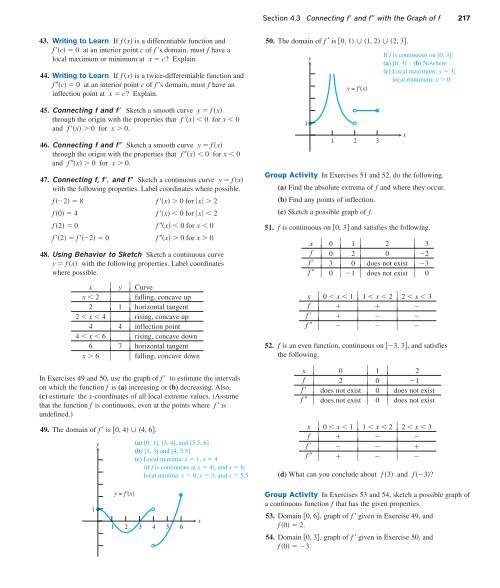5128_Ch04_pp186-260
Create successful ePaper yourself
Turn your PDF publications into a flip-book with our unique Google optimized e-Paper software.
Section 4.3 Connecting f′ and f″ with the Graph of f 217<br />
43. Writing to Learn If f x is a differentiable function and<br />
f c 0 at an interior point c of f ’s domain, must f have a<br />
local maximum or minimum at x c? Explain.<br />
44. Writing to Learn If f x is a twice-differentiable function and<br />
f c 0 at an interior point c of f ’s domain, must f have an<br />
inflection point at x c? Explain.<br />
45. Connecting f and f Sketch a smooth curve y f x<br />
through the origin with the properties that f x 0 for x 0<br />
and f x 0 for x 0.<br />
46. Connecting f and f Sketch a smooth curve y f x<br />
through the origin with the properties that f x 0 for x 0<br />
and f x 0 for x 0.<br />
47. Connecting f, f, and f Sketch a continuous curve y f x<br />
with the following properties. Label coordinates where possible.<br />
f 2 8 f x 0 for x 2<br />
f 0 4 f x 0 for x 2<br />
f 2 0 f x 0 for x 0<br />
f 2 f 2 0 f x 0 for x 0<br />
48. Using Behavior to Sketch Sketch a continuous curve<br />
y f x with the following properties. Label coordinates<br />
where possible.<br />
x ⏐ y ⏐ Curve<br />
x 2 ⏐ ⏐ falling, concave up<br />
2 ⏐ 1 ⏐ horizontal tangent<br />
2 x 4 ⏐ ⏐ rising, concave up<br />
4 ⏐ 4 ⏐ inflection point<br />
4 x 6 ⏐ ⏐ rising, concave down<br />
6 ⏐ 7 ⏐ horizontal tangent<br />
x 6 ⏐ ⏐ falling, concave down<br />
In Exercises 49 and 50, use the graph of f to estimate the intervals<br />
on which the function f is (a) increasing or (b) decreasing. Also,<br />
(c) estimate the x-coordinates of all local extreme values. (Assume<br />
that the function f is continuous, even at the points where f is<br />
undefined.)<br />
49. The domain of f is 0, 4 4, 6.<br />
y<br />
(a) [0, 1], [3, 4], and [5.5, 6]<br />
(b) [1, 3] and [4, 5.5]<br />
(c) Local maxima: x 1, x 4<br />
(if f is continuous at x 4), and x 6;<br />
local minima: x 0, x 3, and x 5.5<br />
50. The domain of f is 0, 1 1, 2 2, 3.<br />
1<br />
y<br />
y = f'(x)<br />
1 2 3<br />
If f is continuous on [0, 3]:<br />
(a) [0, 3] (b) Nowhere<br />
(c) Local maximum: x 3;<br />
local minimum: x 0<br />
Group Activity In Exercises 51 and 52, do the following.<br />
(a) Find the absolute extrema of f and where they occur.<br />
(b) Find any points of inflection.<br />
(c) Sketch a possible graph of f.<br />
51. f is continuous on 0, 3 and satisfies the following.<br />
x ⏐ 0 ⏐ 1 ⏐ 2 ⏐ 3<br />
f ⏐ 0 ⏐ 2 ⏐ 0 ⏐ 2<br />
f ⏐ 3 ⏐ 0 ⏐ does not exist ⏐ 3<br />
f ⏐ 0 ⏐ 1 ⏐ does not exist ⏐ 0<br />
x ⏐ 0 x 1 ⏐ 1 x 2 ⏐ 2 x 3<br />
f ⏐ ⏐ ⏐ <br />
f ⏐ ⏐ ⏐ <br />
f ⏐ ⏐ ⏐ <br />
52. f is an even function, continuous on 3, 3, and satisfies<br />
the following.<br />
x ⏐ 0 ⏐ 1 ⏐ 2<br />
f ⏐ 2 ⏐ 0 ⏐ 1<br />
f ⏐ does not exist ⏐ 0 ⏐ does not exist<br />
f ⏐ does not exist ⏐ 0 ⏐ does not exist<br />
x ⏐ 0 x 1 ⏐ 1 x 2 ⏐ 2 x 3<br />
f ⏐ ⏐ ⏐ <br />
f ⏐ ⏐ ⏐ <br />
f ⏐ ⏐ ⏐ <br />
(d) What can you conclude about f 3 and f 3?<br />
x<br />
1<br />
y = f'(x)<br />
1 2 3 4 5 6<br />
x<br />
Group Activity In Exercises 53 and 54, sketch a possible graph of<br />
a continuous function f that has the given properties.<br />
53. Domain 0, 6, graph of f given in Exercise 49, and<br />
f 0 2.<br />
54. Domain 0, 3, graph of f given in Exercise 50, and<br />
f 0 3.












